Triathlon transitions are critical for a good overall performance so learning how to transition in a triathlon is fundamental to not lose time on your race.
In this guide, we present 12 expert triathlon transition tips that will empower you to optimize your transition process and maintain momentum throughout your race.
You will discover effective strategies, time-saving techniques, and essential insights to ensure your transitions are swift and efficient, and help you stay ahead in the race. So, let’s dive in!
What Are the Triathlon Transition Areas
Transition areas are designated spots where athletes make the switch between different legs of the race. We’ve got two main ones: T1 (the first transition) and T2 (the second transition).
T1, also known as the swim-to-bike transition, is where athletes move from the swimming leg to the cycling leg. You’ll usually find T1 near the water’s edge or a swimming pool. Athletes climb out of the water and head over to the transition area to get ready for the cycling part of the race.
T2, or the bike-to-run transition, is where athletes go from cycling to running. T2 is usually located close to the bike dismount line. It’s the spot where athletes return their bikes and gear before kicking off the final running leg of the triathlon.
In both transition areas, athletes have their own designated space to set up their equipment and gear. Each athlete gets a numbered rack or area to keep things organized and prevent any mix-ups.
The transition area is a buzzing hub of activity during races, with athletes hustling to change their gear and prepare for the next leg.
Smooth and efficient transitions are key because they can make a real difference in the athlete’s overall performance.
The time spent in the transition areas can be the game-changer between winning and losing or even breaking a personal record.
Athletes need to stay organized, focused, and practice their transition strategies to save off those precious seconds and keep their momentum going strong.
12 Triathlon Transition Tips for a Guaranteed Smooth Experience
1. Get there early
Our first triathlon transition tip is probably the more obvious one. Make sure to get to where the triathlon race is taking place as early as possible. Trust me, there is nothing worse than the anxiety you feel when you know you are going to be late for the race!
If the triathlon race is far from where you live, why not make a weekend out of it? Find an airbnb close to the event (if you have the means). This will cut the pre-race nerves and being late won’t be a worry in the back of your mind.
Plus, by being early you will have more time to choose your spot (provided if the race allows it) and double-check the equipment.
2. Prepare your transition area to be clean and organized as you can
This is something that arriving early will allow you to do. Make sure your transition area is clean and well-organized. The idea here is to have it so well set up that you would even be able to go through the transition area in the dark.
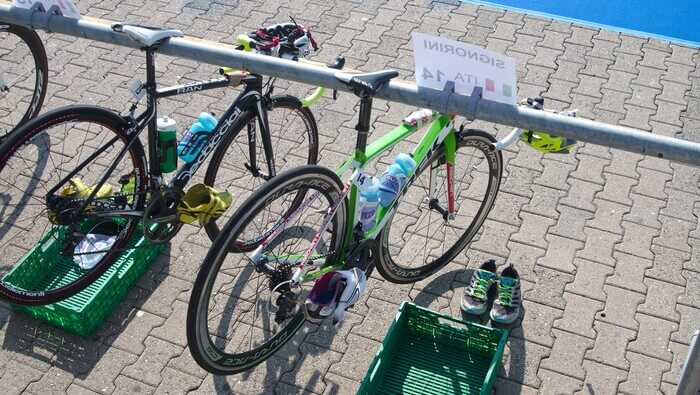
Organize your T1 and T2 gear separately to eliminate any possibility of a mix-up. You don’t want to be running with your bike shoes.
Lay everything out in a manner that is comfortable and familiar to you. Have the gear in order of use. Never clutter the transition area.
To figure out exactly what you need you can use our post on the Triathlon race day checklist. Keep in mind that the best way to figure out what you need is to participate in multiple races and think about what you didn’t need and what you missed.
3. Don’t eat or refuel in the transition area
It always seems like a logical idea to eat and refuel on the transition area but all it does is make you lose time. Furthermore, there is always a chance that during your eating, you forget something important.
Focus on transitioning first, exit the transition area and then eat your energy bars or gels and hydrate your body while on the bike or running.
Having to go back because you forgot something will cost you double. Keep that in mind.
4. Check your tri bike
Always check your bike on race day. This way you will still have time to fix any unexpected issue. What triathlete pros do is what’s called an M check.
The M check is a basic safety check of all the principal parts of the bike. You should move from the front of the bike to the back by following an M shape pattern with your eyes.
This is really useful to quickly identify any problem with the bike.
5. Race other triathletes in the transition areas
The best way to know if you are being fast or slow in the transition areas is to race other triathletes. When you get out of the water or the bike, spot the other triathletes around you and use them as a reference.
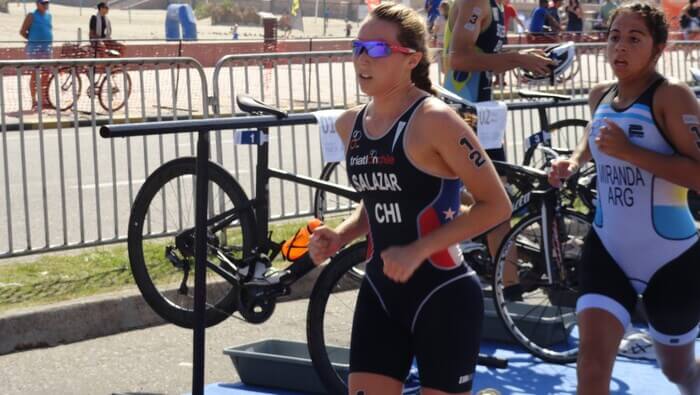
Run past them to your area and try to leave T1 or T2 before they do. It’s a fun little way to gain some time on your opponents. In my case, it helps to maintain my focus as well.
6. Wearing a wetsuit? Lube it up and practice taking it off
Although wetsuits are useful, they are a pain to take off. Our expert triathlon transition tip is to lube your wrists and ankles so that the wetsuit slides off your body. You can also put some anti-chafing cream on your neck while you’re at it.
Another thing you should 100% do is practice taking off the wetsuit. You cannot take a soaking wet wetsuit as fast as you think. The lube will definitely help, but you still have to practice taking the wetsuit off.
Practice on your training sessions after a swim. You can time yourself as an extra challenge to push yourself.
Some of the pro triathletes cut an inch or two off the wetsuit in the legs area. If you do this, be aware that it will reduce buoyancy and warmth.
Here is a quick video explaining how to take off a wetsuit fast.
7. Keep your bike shoes attached to the bike pedals
Attaching your shoes to your bike pedals is a pretty nifty move. It might seem advanced, but there’s a good reason why experienced triathletes swear by it.
Here’s the deal: you strap your shoes onto the bike beforehand, so when it’s time, you hop on, start pedaling, and effortlessly slip into your shoes. It takes some practice to nail this technique but trust me, it’s the slickest way to make your T1 exit.
Oh, and here’s a pro tip: grab a rubber band to keep one of your shoes upright. If you skip this step, both shoes will end up upside down, and you’ll struggle to slide your feet in while on the move.
Here is a video explaining how to rubber band your triathlon shoes to your bike.
8. Find a way to make your transition area stand out
If you have ever seen a triathlon transition area, then you know that it is just a row of identical bikes. This makes it hard to immediately spot yours in an ocean of bikes.
If your bike is at the start or at the end (this is the best place by the way), you should not have problems finding it.
However, if your bike is in the middle, we advise you to find a way to make it stand out from the rest.
There are multiple ways to go about this:
- You can use helium balloons to “mark” your bike;
- Use a colored towel on top of the bike;
- Fit a brightly colored saddle to your tri bike.
9. Have a plan for your socks
Socks on or socks off? This is going to be a personal choice for you. There are triathletes that wear their socks from beginning to end.
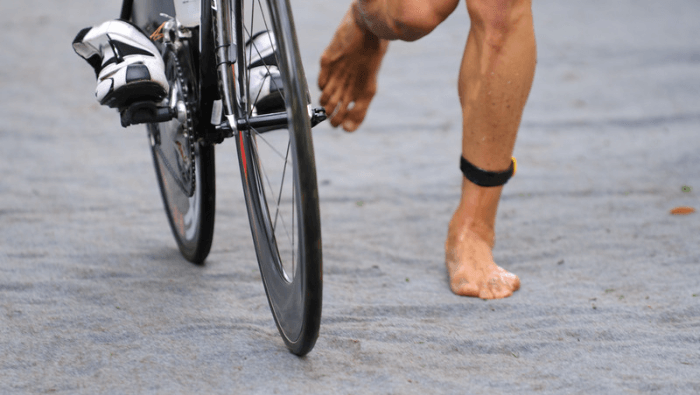
Some triathletes do that because it is tough to put socks on wet feet. We’ve all had that experience in our lives. If you don’t have to put or take your socks off, then that is one less thing to do in the transition areas.
In a similar way, not wearing any socks has the same results although for some they may find it to be uncomfortable in one way or another. For example, I really dislike wearing shoes with no socks on.
If you are in a situation where you have to put your socks on after the swim, make sure to practice putting them on. Like we said before, socks and wet feet are not a good combo.
To help you with this, we have a super secret triathlon transition tip for you. Use baby powder on your feet and shoes. This will make it easier to put your socks on.
10. Practice putting on the helmet
There are rules on the transition areas (more on this later). You will not be allowed to leave T1 without a helmet plus it has to be buckled up.
You can’t just put it on your head either, they will not let you leave and you will lose time. Practice putting the helmet fully on your head and don’t try your luck with the officials. Be respectful of the rules.
11. Be aware of your speed while pedaling
When you are done with the bike section, you will have to enter T2. As you are getting closer and closer to the entry to T2, make an effort to pedal at the same pace that you are about to run.
By doing this, it will be so much easier to deal with your wobbling legs. And remember, don’t eat at the transition area. Eat when you exit and start the run leg of the triathlon.
12. Make sure you know the rules of a Triathlon transition area
Entering a triathlon transition ain’t no walk in the park, my friend. The rules are strict as can be. If you don’t tick off all the boxes, no matter how trivial they may seem, you can kiss your chances goodbye.
Believe it or not, silly stuff like not sealing your handlebars properly, having a banged-up helmet, or riding a wonky bike can put an end to your race before it even kicks off. So pay attention to these details, or you’ll be left in the dust.
What Are the Rules of a Triathlon Transition Area
The triathlon transition areas have rules that are established by the organizers. Failure to follow the rules can result in penalties and in the worst cases, disqualification from the event.
Remember, these rules are here for everyone’s safety and to keep things fair. So, be cool and follow the guidelines.
Get Your Gear in Order: When you arrive at the transition area, make sure to set up your stuff all nice and tidy. Position your bike correctly and arrange your running shoes, helmet, and other essentials in a neat and organized manner.
Wear your race number: Put on your race number after the swimming leg. This is mandatory!
The general rule is:
- On the bike leg have your number on your back;
- On the run leg have your number on the front.
Chip Check: Don’t forget to strap on your timing chip! It’s like a little ankle bracelet that keeps track of your race time. Make sure it’s securely fastened according to the instructions given by the event organizers.
Bike Basics: Your trusty steed should be in tip-top shape and meet all the safety requirements. Give those tires a good pump, check that your brakes are working smoothly, and ensure your gears are shifting like a dream. Any major defects or damages could lead to a disqualification, so keep your bike in check.
Helmets: Safety first, my friend! Wear an approved helmet that’s in good condition. Make sure it fits snugly and secure the straps under your chin. We don’t want any mishaps on the road!
Make sure to always fasten your helmet before leaving T1 and always take off your helmet when you are out of your bike in T2.
Handlebars: Tighten those handlebars and seal them up properly. Loose or wobbly handlebars can mess up your control during the race. Keep things sturdy and steady.
Transition Etiquette: Play nice and be considerate of your fellow triathletes. Don’t hog the space and don’t block anyone’s access to their gear. Move smoothly and keep the transition area flowing like a well-oiled machine.
Do not mount your bike before the mount line: To exit T1 you must walk your bike until one foot is completely on the other side of the mount line.
Conclusion
Triathlon transitions may be brief, but their impact on your overall race performance should not be underestimated.
By following these 12 triathlon transition tips, you’ll optimize your time in the transition area, maintain momentum, and give yourself a competitive edge.
Remember to practice, stay organized, and focus on speed and efficiency. With dedication and smart preparation, you’ll be well on your way to achieving your triathlon goals.
Good luck, and enjoy the thrill of the race!



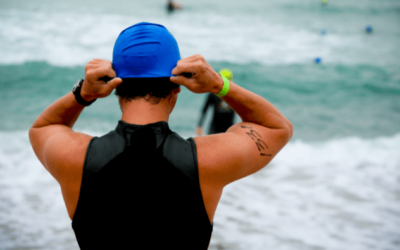
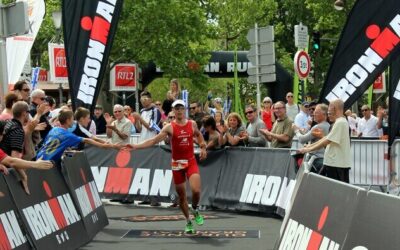
0 Comments